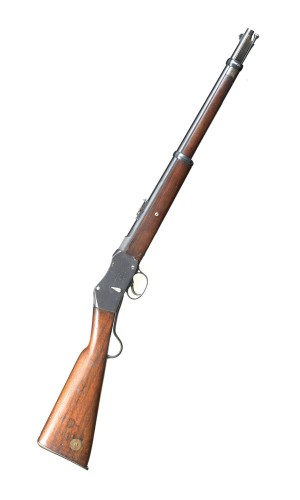IC1 Cavalry Carbine
| Calibre | .577/450” |
| Date of Approval | 24th September 1877 |
| Length | 37.6” (95.5 cm) |
| Weight | 7lb 8oz |
24th Sept 1877. LOC 3215 as “As Arms Interchangeable, Carbine Breech loading Rifled, with clearing rod Martini Henry Mk1.”
The experiments with a Martini Carbine began as early as February 1871, with a shortened rifle, after six trial models, on the 6th June 1876, a New pattern was offered and approved, built upon the reciever frame of a MkII rifle.
Martini Henry Cavalry Carbines
The Pattern was sealed and introduced on the 24th Sept 1877. LOC 3215 as “As Arms Interchangeable, Carbine Breech loading Rifled, with clearing rod Martini Henry Mk1.” “Interchangeable” was to be used in the description, and the actions were marked I.C.1. Not only did it simplify production, the carbine could be made as basic arm, with uniformed manufacturing techniques, sharing common rifle and carbine component parts, but providing an arm which simply required a change of furniture to convert from Artillery to cavalry. The new stocking arrangement required a re-think as to how the fore-end was to be fixed, the new slim barrel design did not facilitate a traditional lug hole and cross pin method of fixing used on the Mk1 & MkII rifle, so as a result a new steel hook was screwed into the bottom of the fore-stock, this in turn located into a slot in the front of the receiver.
The design carried a 21.3” lightweight barrel, and the carbines’ weight was reduced to 7lb 8oz. Developments with the new single part tumbler for the proposed MKII rifle gave the new arm a positive cocking action, the original pattern arm had a combined half cock thumb catch on the right of the action body. To eliminate the “catch points” the front of action was rounded off to allow the carbine to slide into saddle bucket, and two rigid “Wings” protected the foresight. Most obvious external change was a new smaller cocking indicator providing too less external projection. In 1876, the safety thumb-piece catch was discontinued and not adopted.
Production costs of the new carbine per arm was £2.10s 7d.
Complaints were reported of the rear sight leaf becoming entangled or damaged by the saddlery, on the 18.4.1879, the IC1 Cavalry carbines were supplied with a folding leather back sight protector held by two screws, the screw edges were sharp and it caught clothing. A List of change No 3566 3.7.1879 gave simple instructions that the screw heads were to be softened and rounded.
Between the years 1878 and 1889 the RSAF Enfield made 130,000 IC1 carbines, but with the adoption of the .303” calibre in the regular army, production ceased, with most of the component parts being utilized in the conversion to .303 Martini Metford and Martini Enfield carbines. IC1 Carbines emanating from the Birmingham Small Arms factory have never been seen by the author, their factory returns report that they had made over 1600 pieces in the 1890’s, however, it is believed that these were made under contract by the Henry Rifled Barrel company, with parts supplied from Enfield.
In 1892, Henry Rifled Barrel Co were awarded the contract for 30,000 I.C.1 Cavalry carbines from the Indian Government. These examples were manufactured over a two year period under full Governmental Viewing, and can be found dated 1893 & 1894.







